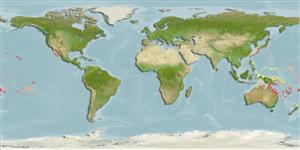>
Blenniiformes (Blennies) >
Blenniidae (Combtooth blennies) > Salariinae
Etymology: Stanulus: Latin, stagnum, stannum = alloy of silver and tin (Ref. 45335).
Issue
Tribe Salarinii
Environment: milieu / climate zone / depth range / distribution range
Ecología
marino asociado a arrecife; rango de profundidad 3 - 15 m (Ref. 9710). Tropical
Distribución
Países | Áreas FAO | Ecosistemas | Ocurrencias, apariciones | Point map | Introducciones | Faunafri
Western Pacific: Ryukyu and Ogasawara islands and the southern Great Barrier Reef and Lord Howe Island. Reported from Tonga (Ref. 53797) and the Marquesan Islands (Ref. 9710).
Tamaño / Peso / Age
Maturity: Lm ? range ? - ? cm
Max length : 4.8 cm TL macho / no sexado; (Ref. 2334)
Short description
Claves de identificación | Morfología | Morfometría
Espinas dorsales (total) : 12; Radios blandos dorsales (total) : 11 - 13; Espinas anales: 2; Radios blandos anales: 12 - 13. Distinguished from Entomacrodus by scalelike flaps on anterior portion of lateral line, fewer dorsal and anal fins, and more pectoral fin elements. Nasal, supraorbital and nuchal cirri simple and short. Both sexes without occipital crest.
Adults are found in the surge channel zone of exposed outer reefs. Oviparous. Eggs are demersal and adhesive (Ref. 205), and are attached to the substrate via a filamentous, adhesive pad or pedestal (Ref. 94114). Larvae are planktonic, often found in shallow, coastal waters (Ref. 94114).
Life cycle and mating behavior
Maturities | Reproducción | Spawnings | Egg(s) | Fecundities | Larva
Oviparous, distinct pairing (Ref. 205).
Randall, J.E., G.R. Allen and R.C. Steene, 1990. Fishes of the Great Barrier Reef and Coral Sea. University of Hawaii Press, Honolulu, Hawaii. 506 p. (Ref. 2334)
IUCN Red List Status (Ref. 130435)
Threat to humans
Harmless
Human uses
Pesquerías: comercial; Acuario: Comercial
Herramientas
Special reports
Download XML
Fuentes de Internet
Estimates based on models
Preferred temperature (Ref.
123201): 21.6 - 28.1, mean 26.1 °C (based on 683 cells).
Phylogenetic diversity index (Ref.
82804): PD
50 = 0.7500 [Uniqueness, from 0.5 = low to 2.0 = high].
Bayesian length-weight: a=0.00741 (0.00335 - 0.01640), b=3.02 (2.83 - 3.21), in cm total length, based on LWR estimates for this (Sub)family-body shape (Ref.
93245).
Nivel trófico (Ref.
69278): 2.0 ±0.00 se; based on food items.
Resiliencia (Ref.
120179): Alto, población duplicada en un tiempo mínimo inferior a 15 meses (Preliminary K or Fecundity.).
Fishing Vulnerability (Ref.
59153): Low vulnerability (10 of 100).
Nutrients (Ref.
124155): Calcium = 277 [133, 555] mg/100g; Iron = 1.2 [0.6, 2.2] mg/100g; Protein = 17.7 [16.4, 18.9] %; Omega3 = 0.0906 [, ] g/100g; Selenium = 26.1 [10.7, 65.3] μg/100g; VitaminA = 114 [26, 506] μg/100g; Zinc = 3.72 [2.31, 5.66] mg/100g (wet weight);
